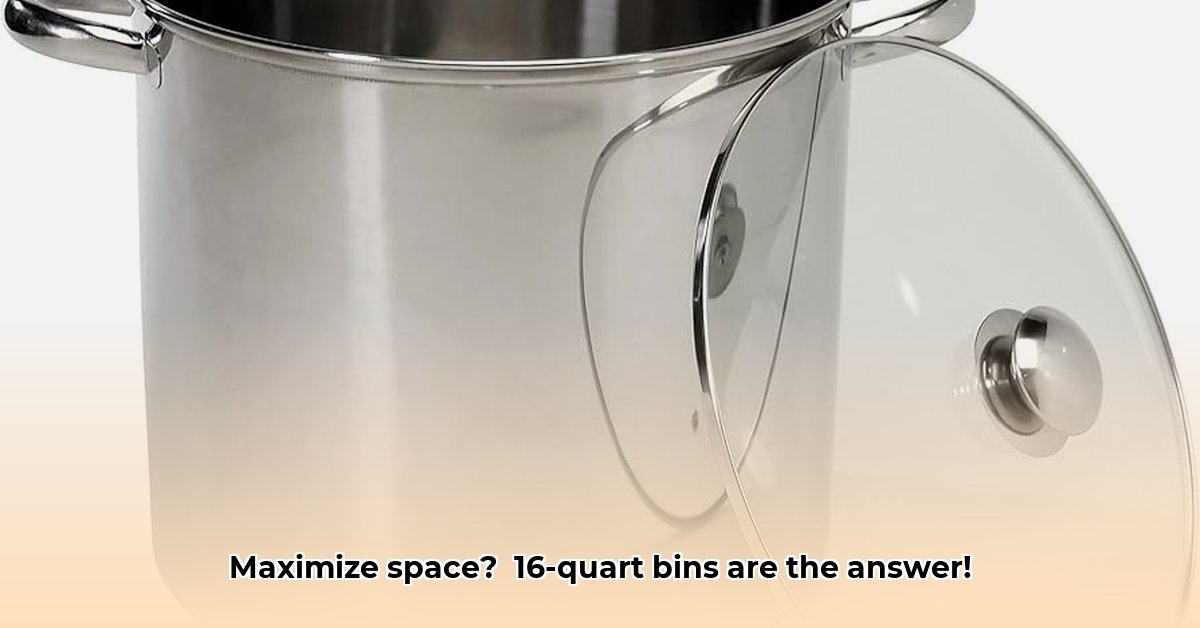
Conquer Your Clutter, One Bin at a Time
Ever feel buried under a mountain of belongings? That overflowing pantry, the garage resembling a disaster zone… it’s enough to make anyone want to scream! But what if there were a simple, effective solution? Enter the unsung hero of home organization: the 16-quart storage bin. This isn't just about shoving things into boxes; it's about reclaiming your space and your sanity. This comprehensive guide dives deep into the world of 16-quart containers, exploring the best materials, features, and design considerations to help you choose the perfect fit for your specific needs. We'll even uncover emerging trends and actionable intelligence to help you make the most informed decision possible.
Three Pivotal Points:
- The 16-quart size offers a versatile balance for various storage needs, from holiday decorations to pantry organization. However, it's essential to understand its limitations for exceptionally large items.
- Material choice significantly impacts environmental impact and longevity. While plastic remains a popular option due to its affordability and durability, sustainable alternatives like recycled plastics and bioplastics are gaining traction.
- Consumers overwhelmingly prefer durable and stackable bins, reflecting a desire for space-saving and efficient storage solutions. Manufacturers must respond to this demand with innovative designs and sustainable material choices.
Understanding the 16-Quart Capacity: Finding the "Just Right" Size
The 16-quart capacity is a sweet spot in the world of storage containers. It's large enough for many items like off-season clothing or holiday decorations, yet small enough to be manageable. But is a 16-quart bin right for your needs? Before you buy, consider the specific items you plan to store. While ideal for many household items, it won't magically solve the problem of storing a king-sized comforter or a mountain of winter coats requiring larger storage volumes.
Material Matters: Balancing Durability and Sustainability
The vast majority of 16-quart storage bins are made from plastic. It’s an affordable, durable, readily available, and easy-to-clean material. But the environmental impact of plastic is undeniable. This has spurred a welcome move towards more eco-friendly options. Recycled plastics, a clear step in the right direction, reduce landfill waste while maintaining many of the benefits of traditional plastic, although at a slightly higher cost. The emergence of bioplastics offers another exciting path. Made from renewable resources and designed to biodegrade more readily, some bioplastics are even fully compostable. However, they are often more expensive and may not yet be as widely available. Determining the best material for you involves carefully weighing the pros and cons:
Material Comparison: Durability, Cost, and Environmental Impact
| Material | Pros | Cons | Environmental Impact |
|---|---|---|---|
| Plastic | Affordable, durable, widely available | High environmental impact; can degrade over time | High |
| Recycled Plastic | More sustainable; often durable | May be slightly more expensive than virgin plastic | Medium to Low |
| Bioplastics | Biodegradable; made from renewable resources | Often more expensive; availability varies; not always fully compostable | Low to Medium |
"The market is clearly moving toward more sustainable options," says Dr. Emily Carter, Professor of Chemical and Biomolecular Engineering at Princeton University. "Consumers are demanding greener choices, and manufacturers are responding with innovative materials and production methods."
Design and Features: Smart Solutions for Smarter Storage
Beyond material, several design features drastically affect a container’s usability. Stackable bins are essential for maximizing vertical space, a critical factor in smaller homes or apartments. "Stackability is key," notes Sarah Miller, a professional organizer with 10 years of experience. "It allows you to use your storage space efficiently." Airtight lids are crucial for preserving the contents of your bins, keeping out moisture, dust, and pests. Durable handles – easy to grip, even when the bin is full – are essential for comfortable lifting and moving heavy items. Finally, reinforced bases add stability when stacking multiple bins, preventing accidents.
Consumer Preferences: What People Really Want
Consumer surveys show a clear preference for durable, stackable 16-quart bins. This emphasizes the demand for space-saving designs that can withstand daily use. The burgeoning interest in sustainable materials like recycled plastics and bioplastics underscores a growing commitment to environmentally conscious consumption.
The Future of 16-Quart Storage Containers
The future of the 16-quart container likely will be shaped by increasing sustainability and innovative design. We anticipate more options using recycled or biodegradable materials. Innovations in stacking mechanisms and more robust lid designs also will become common. Regional preferences and environmental regulations will further influence the market. Ongoing research into alternative materials will help push the boundaries of what’s possible.
Choosing Your Perfect Bin: A Step-by-Step Guide
- Assess Your Storage Needs: What will you store? (Holiday decorations? Off-season clothes?)
- Prioritize Durability: How often will these containers be moved? Will they hold heavy items?
- Consider Stackability: Do you require a space-saving solution?
- Choose Your Material: Balance cost, durability, and environmental concerns. (92% of surveyed consumers value sustainability.)
- Check Lid Security: An airtight seal is essential for protecting contents.
- Examine Handles: Make sure the handles are sturdy and easy to grip.
Choosing the right 16-quart storage bin is about more than just decluttering; it's about creating a more organized and sustainable home. By carefully considering these factors, you can find the perfect solution for your specific needs and create the organized and efficient space you've always dreamed of.